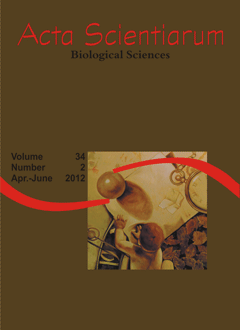<b>Genetic variability of wild and captivity populations of <i>Colossoma macropomum</i> (Cuvier, 1818)</b> - doi: 10.4025/actascibiolsci.v34i2.7149
Resumo
Tambaqui (Colossoma macropomum) is among the most important fish species of the Amazon and one of the most cultivated in Brazil. In the present work we have evaluated the genetic variability of wild and captivity populations of C. macropomum. Enzymatic markers were used to estimate the genetic variability of 41 specimens from a wild group; and 30, 33 and 45 from three captivity groups, which came from Pentecostes (Ceará State), Jaboticabal (São Paulo State) and Itacoatiara (Amazonas State), respectively. Nine isoenzymic systems were used to evaluate the genetic variability of these populations. Using zimogram data we obtained the polymorphism level, allele number, allelic frequency, observed and expected heterozigosity, Wright F statistics (FIS, FST), genetic distance, level of similarity and group analysis. The isoenzymic data showed that, from the nine systems, six presented polymorphic loci (Fbp-2, G6pdh-2, G6pdh-3, Pgi-1, Pgi-2 and Pgm-1). The populations from Pentecostes and Jaboticabal presented loss of genetic variability and low heterozigosity, compared to the wild population and to the artificial population acquired at Itacoatiara fish farm. Based on these results and on fish farmer information we could consider the population from Itacoatiara as recently derived from a wild population. Concluding, we suggest that the artificial populations of tambaqui, which contain animals originated from this funding population at Pentecostes, should be renewed with the introduction of a new group of individuals with genetic variability equivalent to the wild population.
Downloads
DECLARAÇÃO DE ORIGINALIDADE E DIREITOS AUTORAIS
Declaro que o presente artigo é original, não tendo sido submetido à publicação em qualquer outro periódico nacional ou internacional, quer seja em parte ou em sua totalidade.
Os direitos autorais pertencem exclusivamente aos autores. Os direitos de licenciamento utilizados pelo periódico é a licença Creative Commons Attribution 4.0 (CC BY 4.0): são permitidos o compartilhamento (cópia e distribuição do material em qualqer meio ou formato) e adaptação (remix, transformação e criação de material a partir do conteúdo assim licenciado para quaisquer fins, inclusive comerciais.
Recomenda-se a leitura desse link para maiores informações sobre o tema: fornecimento de créditos e referências de forma correta, entre outros detalhes cruciais para uso adequado do material licenciado.












1.png)




3.png)













